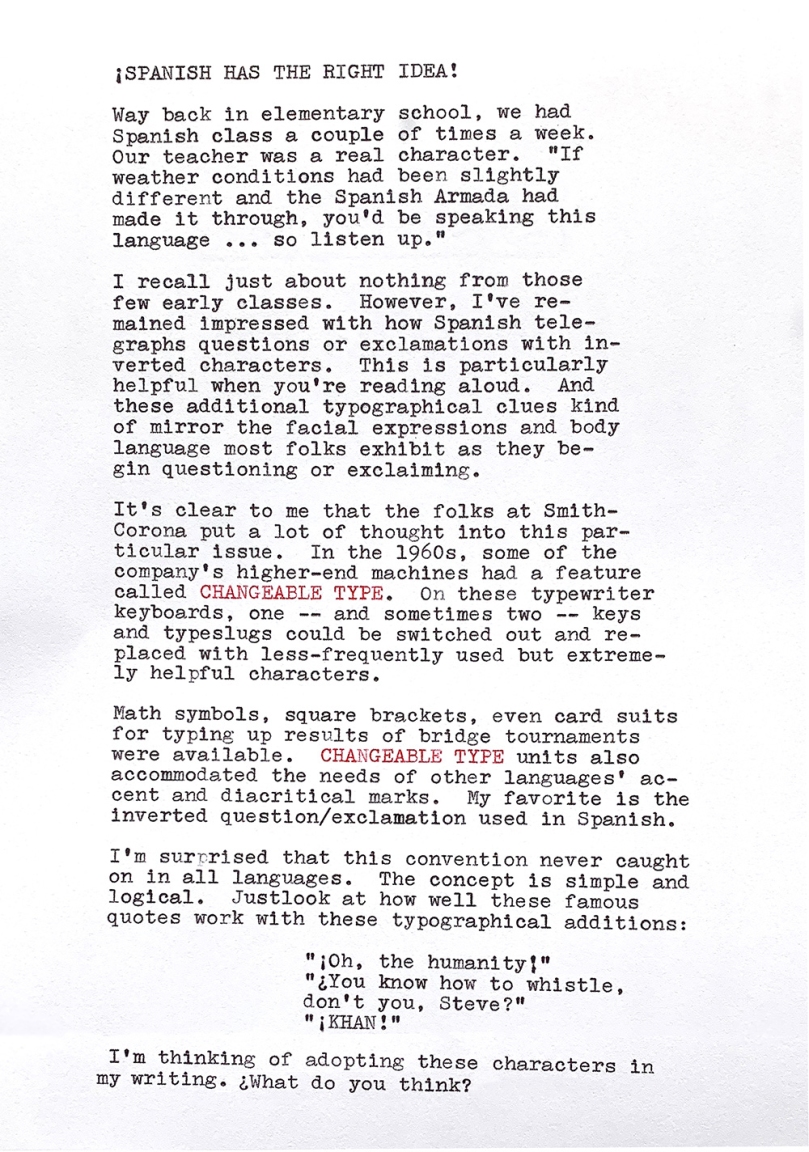
Here’s an interesting guide to Smith-Corona CHANGEABLE TYPE. And here’s some history of the inverted question and exclamation marks.

Here’s an interesting guide to Smith-Corona CHANGEABLE TYPE. And here’s some history of the inverted question and exclamation marks.
I’ve wondered the same, and I don’t think it would be hard to adjust to the practice in reading or writing.
LikeLike
It’s a good idea, though I doubt it’s going to happen. You might get more people on board, though, if you render the adoption of new symbols moot: ?Why not use the standard marks at both ends of the sentence? !It works just as well!
I’ve recently started studying Spanish, and I’ve learned that one reason for the Spanish method is that in that language, questions are often formed with no helper words or change in word order. ¿Él habla español? Sí, él habla español. So the initial question mark helps clue you in in the absence of English’s “Do…?” and “Does…?”, and its occasional inverted word order: “Have you any…?” Interestingly, the initial mark doesn’t have to come at the beginning of the sentence, just at the beginning of the grammatical phrase. “Yo te pregunto, ¿es ese verdad?” I guess that’s covered by the Wikipedia article that you linked to.
Diacritical marks were the first keys I added to my Galaxie Deluxe XII. But then I got a Spanish typewriter, which is better, because the accents are better aligned with the letters and there’s no backspacing involved.
LikeLiked by 1 person
Good idea about putting the standard versions in front. Would this also would work with interrobangs!?
LikeLike
I’m not a big fan of interrobangs—they’re cute, but the version you just used serves just as well!
LikeLike
The trouble with the interrobang character is that it looks as if the question mark and exclamation point have accidentally been smashed together. You’re right that “!?” or “?!” looks better.
LikeLiked by 1 person
“¿What do you think?” certainly caught me off guard. ¡Very effective!
LikeLiked by 1 person
Good idea – a reason for me to bust out my Mexican-American border market machines (fairly common find here in AZ).
LikeLiked by 1 person
I worked for newspapers in Kingman and Phoenix many years back. A Spanish keyboard could have saved us from an embarrassing typo. I worked on an edition that printed stories both in English and Spanish. Usually, the English version was written first, then a Spanish translation prepared. In those pre-desktop publishing days, we had to insert arcane coding to create diacriticals, and as luck would have it, somebody omitted a tilde command in a headline, and the copy desk didn’t catch it. The result was that instead of “Lopez: Man of the Year” being printed in Spanish as “Lopez: Hombre del Año,” we wound up telling our readers that the honoree was “Lopez: Hombre del Ano,” which translates as “Lopez: Man of the Anus.”
LikeLiked by 1 person
The embarrassment potential is heightened when you realize that in Spanish, you’re not x “years old” — you “have x years.” So complementing someone on their beautiful toddler who “tiene dos anos” has an unfortunate medical implication.
LikeLiked by 1 person